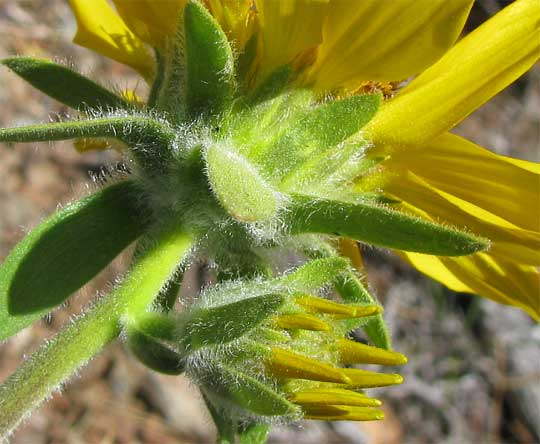Excerpts from Jim Conrad's
Naturalist Newsletter

from the the May 3, 2009 Newsletter, issued from the Siskiyou Mountains west of Grants Pass, Oregon:
BALSAMROOT FLOWERING
Sunflower species and close relatives nearly always blossom in late summer and fall so I was surprised this week as I backpacked across a mountainside serpentine barren and saw the knee-high flowers seen above.
Was this a serpentine-adapted sunflower? Turning the flower head over with my fingers I saw that this was no sunflower, as is made clear below:
 .
.
What you see there is two series of involucral bracts, or phyllaries, which no sunflower has. Remember that sunflower-type flowers are actually clusters of many flowers held in a flower-like head -- a composite flower. Typically each flower head is subtended by green, scale-like involucral bracts such as those shown on the underside of a chrysanthemum flower at http://www.backyardnature.net/pix/recep-br.jpg.
That chrysanthemum flower is equipped with just one kind of involucral bract, many of them overlapping one another in two or three series. That's typical of most composite flower heads. But that's not what our sunflower-like plant from the serpentine barren has. It possesses two completely unlike series of involucral bracts, the lower ones much larger than the top ones, and the lower ones point downward while the top ones stay directed upwardly. Little differences like this are profoundly important when distinguishing look-alike plants.
Our "serpentine sunflower" is the Deltoid Balsamroot, also called Puget Balsamroot, BALSAMORHIZA DELTOIDEA. It's fairly common on grassy slopes and in open forests and shrubby areas from British Columbia through our region and most of California. You can eat the sweet-tasting roots or cook them. Its seeds can be roasted, ground and used like coffee. Medicinally, a decoction of its split roots has been used for treating coughs and colds.